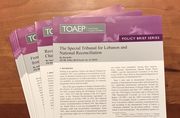Table of contents:
Element:
5. The perpetrator killed one or more persons
The Mucić et al. ("Čelebići") Trial Chamber stated:
"It is apparent that it is a general principle of law that the establishment of criminal culpability requires an analysis of two aspects. The first of these may be termed the actus reus - the physical act necessary for the offence. In relation to homicide of all natures, this actus reus is clearly the death of the victim as a result of the actions of the accused. The Trial Chamber finds it unnecessary to dwell on this issue, although it notes that omissions as well as concrete actions can satisfy the actus reus element and, further, that the conduct of the accused must be a substantial cause of the death of the victim."[1]
"The Trial Chamber takes the view that it is the simple essence of these offences, derived from the ordinary meaning of their terms in the context of the Geneva Conventions, which must be outlined in the abstract before they are given concrete form and substance in relation to the facts alleged. With this in mind, there can be no line drawn between "wilful killing" and "murder" which affects their content."[2]
This view was confirmed by the Trial Chambers of both Krstić and Kvočka and Čerkež
"Murder has consistently been defined by the ICTY and the ICTR as the death of the victim resulting from an act or omission of the accused committed with the intention to kill or to cause serious bodily harm which he/she should reasonably have known might lead to death." "[3]
"The ICTY and the ICTR have consistently defined the crime of murder as requiring that the death of the victim result from an act or omission of the accused committed with the intent to kill, or with the intent to cause serious bodily harm which the perpetrator should reasonably have known might lead to death." "[4]
The Trial Chamber held in Orić that:
"To establish the actus reus of murder, the Prosecution must prove beyond reasonable doubt that the perpetrator's conduct contributed substantially to the death of the person. This does not necessarily require proof that the dead body of that person has been recovered. A person's death can be inferred circumstantially, provided that is the only reasonable inference that can be drawn."[5]
In the Lukić and Lukić case, the Trial Chamber explained that:
" In addition, Article 3 requires the proof of the victim being a person who was taking no active part in the hostilities at the time of his death. It is not required that the perpetrator intended to target a specific individual. [...] The physical perpetrator's act or omission need not have been the sole cause for the victim's death; it is sufficient that the "perpetrator's conduct contributed substantially to the death of the person"." "[6]
"There is no requirement that the body of the victim has been recovered for the proof of death to be established. The death may be established by circumstantial evidence, provided that the only reasonable inference available from the evidence presented to the Trial Chamber is that "the victim is dead as a result of acts or omissions of the accused or of one or more persons for whom the accused is criminally responsible". The Trial Chamber notes that relevant factors to be considered include proof of incidents of mistreatment directed against the victim, patterns of mistreatment and disappearances of other victims, the coincident or near-coincident time of death of other victims, the fact that the victims were present in an area where an armed attack was carried out, when, where and the circumstances in which the victim was last seen, behaviour of soldiers in the vicinity, as well as towards other civilians, at the relevant time, and lack of contact by the victim with others whom the victim would have been expected to contact, such as his or her family "[7]
In the Milutinović et al. case, the Trial Chamber held that:
"The actus reus for murder is the death of an individual as a result of an act or omission of the physical perpetrator. With regard to the causation requirement, the specification that death must have occurred "as a result of" the physical perpetrator's act or omission need not have been the sole cause for the victim's death; it is sufficient that the "perpetrator's conduct contributed substantially to the death of the person". While causation may be inferred from the circumstances of the case, that conclusion must be the only reasonable inference to be drawn from the evidence adduced at trial."[8]
Prosecutor v. Jovica Stanišić and Franko Simatović, Case No. IT-03-69-T, Judgement (TC), 30 May 2013, para. 135:
"135. The Trial Chamber further received evidence about the deaths of other people on 18 November 1991 in Škabrnja. It considers, however, that there is a reasonable possibility that these persons died as a result of collateral damage or an accident. The Trial Chamber will therefore not further consider the deaths of Jela Jurić, Grgo Bilaver, Peka Bilaver, Ana Brkić, Dumica Gospić, Anica Jurić, Mirko Kardum, Milka Žilić, and Pavica Žilić in relation to this incident."
5.1.1. Killing by direct methods
According to the Trial Chamber in Ntagerura et al.,
"The Chamber has found that soldiers under Imanishimwe's effective control participated in the killing of refugees at the Gashirabwoba football field. A group of at least fifteen armed soldiers surrounded the refugees and, after the refugees had raised their hands and asked for peace, the soldiers fired and threw grenades at them for about thirty minutes, killing many of the refugees. The Chamber consequently finds that in doing so the soldiers engaged in intentional killing of the refugees within the scope of Article 4(a) of the Statute."[9]
5.1.2. Killing by indirect methods
The Kaing Trial Chamber found:
"detainees died at S-21 as the result of omissions known to be likely to lead to death and as a consequence of the conditions of detention imposed upon them."[10]
Footnotes:
[1] ICTY, Mucić et al. ("Čelebići") Trial Judgment, 16 November 1998, para. 424.
[2] ICTY, Mucić et al. ("Čelebići") Trial Judgment, 16 November 1998, para. 422.
[3] ICTY, Krstić Trial Judgment, 02 August 2001, para. 485.
[4] ICTY, Kvočka Trial Judgment, 2 November 2001, para. 132.
[5] ICTY, Orić Trial Judgment 30 June 2006 para. 347. (footnotes omitted).
[6] ICTY, Lukić and Lukić Trial Judgment, 20 July 2009, para.903.
[7] ICTY, Lukić and Lukić Trial Judgment, 20 July 2009, para. 904.
[8] ICTY, Milutinović et al. Trial Judgment, 26 February 2009, au para.137.
[9] ICTR, Ntagerura et al. Trial Judgment 25 February 2004, para. 794.
[10] ICTR, Kaing Trial Jugdment, 26 July 2010, para. 437.







